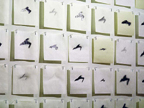Michael Maranda
Aufhebung [history]
1,540 drawings, each 25X25cm
graphite on paper
1996-98
statement . . .
This visual project revolves around notions of history as an empty frame, as a flow-chart that is made
to be filled in very particular manners, with very particular materials. Each drawing in the series is not technically
a drawing as it is indeed written — the word, aufhebung (the German word that denotes the successful
resolution of the dialectic), is written and overwritten to the point of unintelligibility at which point it ceases
to be a written text (but it might be a form of écriture). The form that the word takes is not so
important as the practice of writing it N+1 times, to the point of illegibility, while still retaining a shape identifiable
within the context of the series, as being the same — equivocal but not identical. Thus, the generic indication
in title, or in caption, is enough to indicate to a viewer the source and context of the piece.
Aufhebung does not happen in an action (such as a drawing or a revolution) but it is optimistically hypothesized
in a narrative of that action. If it ever does occur, it is only after the fact in the marking of that action as an
event, as significant within the pre-existing narrative of progress which is history. In the post facto marking of
the action, the event post-dates the narrative and the narrative pre-dates the action. For an historical event to
repeat itself is to fail in the teleological process, is to achieve at most a glorified stagnation. Thus I enact the
rules of the game — in a narrativist event and not in a narration of an event — to see the making legible
of the structure of the rhetoric at the same time that the disjuncture between this structure and any content that
it might presume to contain.
The series consists of a group of 25x25cm graphite on paper drawings. Each separate drawing uses a unique combination
of three pencils and, as there are 20 different grades of pencils available, there are a total of 1540 drawings. While
various techniques are used in the process of the drawing which affect its appearance — erasing, blending, and
abrading — the application of the graphite is done only through the writing of the word.
The drawings are arranged in a 30x30cm grid that extends from floor to ceiling. Suspended precariously on the ends
of nails which extend 5cm from the wall, they react to the movement of the viewer to the point of, in the case of
overly mobile viewers, falling to the floor.
exhibitions . . .
1998
• Solo. Galerie B312 (Montréal)
1996
• Group. Hartnett Gallery, University of Rochester
reviews . . .
2002
• Lehmann, Henry. “Scrutiny only Deepens the Mystery,” The Montreal Gazette (April 4, 1988), p.J6.
